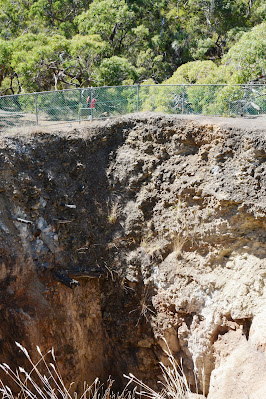Urimbirra is a family-owned open-range wildlife park just 5 minutes from home - and we've never been there despite living here for nearly eight years! The land is part of a wetland system and had long been an Aboriginal hunting ground; there is still evidence of canoe and shield trees there. The name means 'to preserve' or 'to take care of' in the local Aboriginal language and is an apt name for what the owners have set out to do. The park covers 40 acres of grassed area, bush and wetlands and is home to more than 400 native animals including koalas, emus, wombats, echidnas, kangaroos, snakes, dingoes, crocodiles, many birds, and a cassowary, as well as farm animals such as alpacas, sheep, and chooks. Intriguingly there were two quokkas very far from their Rottnest Island habitat but who were jumping about and seemingly at home here.
The reason we were there was to celebrate the joint birthdays of two of our friends who had arranged a barbecue in one of the sheltered pavilions. However, we arrived early before the festivities, and set off to explore.
There were numerous paths meandering around the park providing access to all the attractions. Rain was threatening, but thankfully holding off, so it was all a bit overcast and dull.
I love our Australian birds with their gorgeous colours.We couldn't resist taking photos.
The next three photos are Steve's.
A lot of the birds and other animals are in spacious cages replicating their natural bushland environment...

... but some have a large, though fenced-off, open space in which to roam, like the emu.


On the other hand the kangaroos and wallabies have open slather in large swathes of open grassland which overseas visitors must love.
I still get a kick out of watching a mother and joey.
And Steve still enjoys getting a good photo.
And even though we are very familiar with koalas as there were many of them living in the trees on our Bolwarra property, it was good to see them greedily guzzling the gum leaves.
The cassowary is a strange creature and I felt a little bit sorry for him so far away from his stomping ground in the tropical rainforests of Queensland. But he had a fair bit of space to tromp around in including a large spooky, swampy area. The informative plaque on the fence explained that cassowary are one of the closest living species to dinosaurs as evidenced by their clawed feet, and the distinct horn on their head (which apparently is called a 'casque').
Of course it was not all 'Oh isn't that bird gorgeous' or 'I love the emu's floaty feathers' because we suddenly came upon a couple of saltwater crocodiles, the meanest of the mean, but thankfully fully enclosed in their watery domain.
The sign says it all.
I was still out of my comfort zone when we came upon the reptiles - a death adder, an eastern tiger snake, and a python. First up, some harmless lizards.
Fortunately these reptiles were securely ensconced behind glass walls!
What a relief it was to venture further on and spot this quirky 'dinosaur'.
It was a wonderful visit. While we were familiar with most of the animals, I can imagine overseas visitors being excited at being allowed to feed and pat the koalas and kangaroos. Management also run programs for children to encourage their interest in the wildlife, educate them about the animals' needs and provide opportunities for them to handle and gain skills in looking after them.
We then walked back to the barbecue area and our friends' birthday party and finished a happy day with bubbly, sausages and onions, and the creamiest sponge cake I've ever tasted.

















































